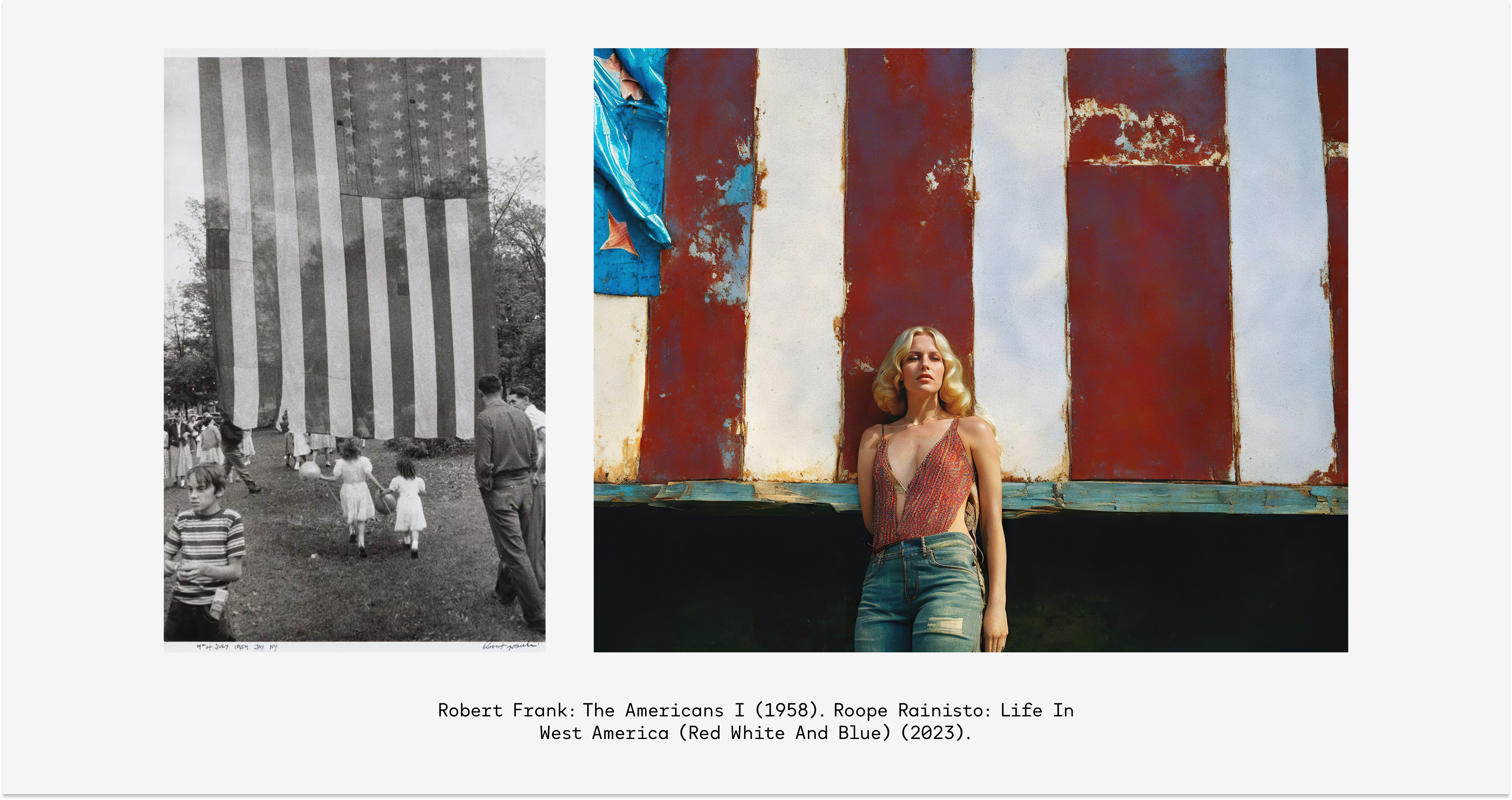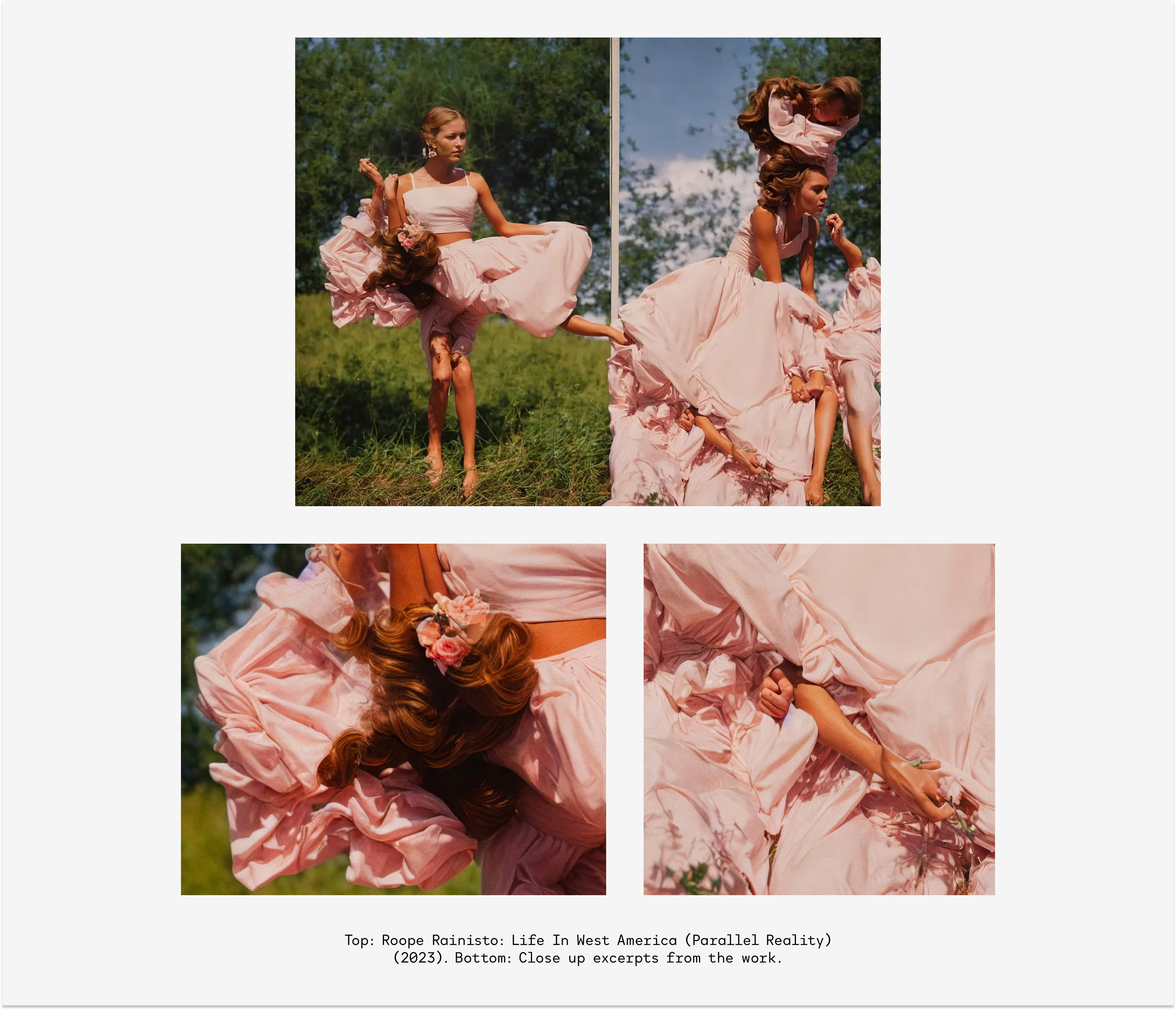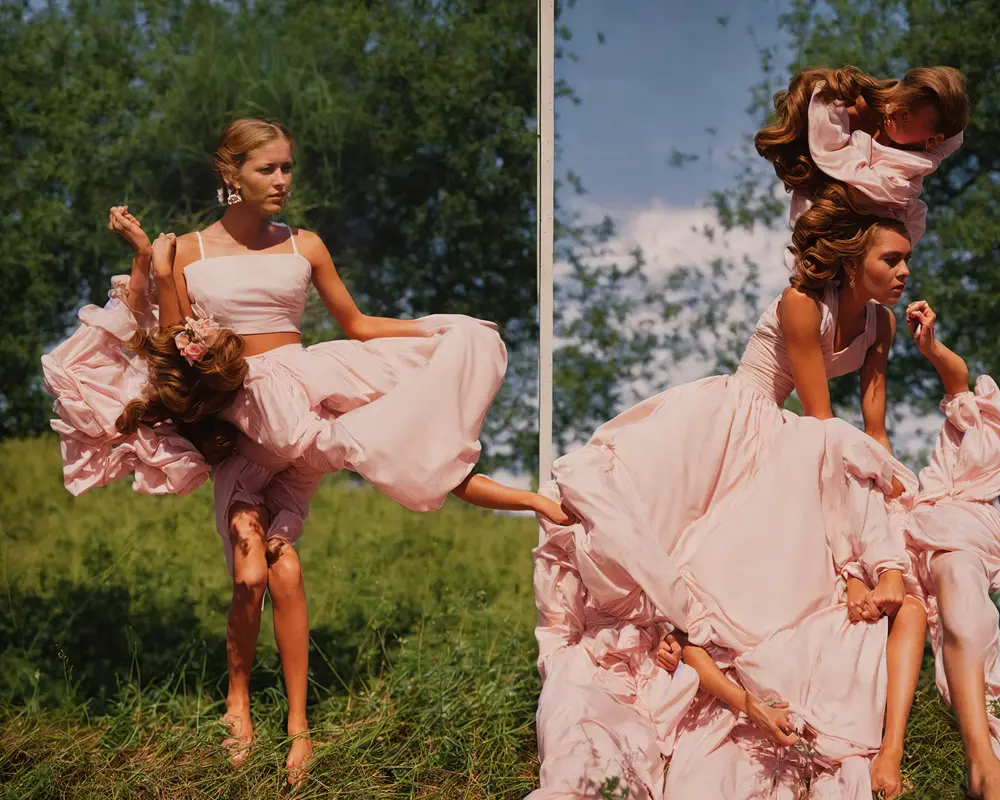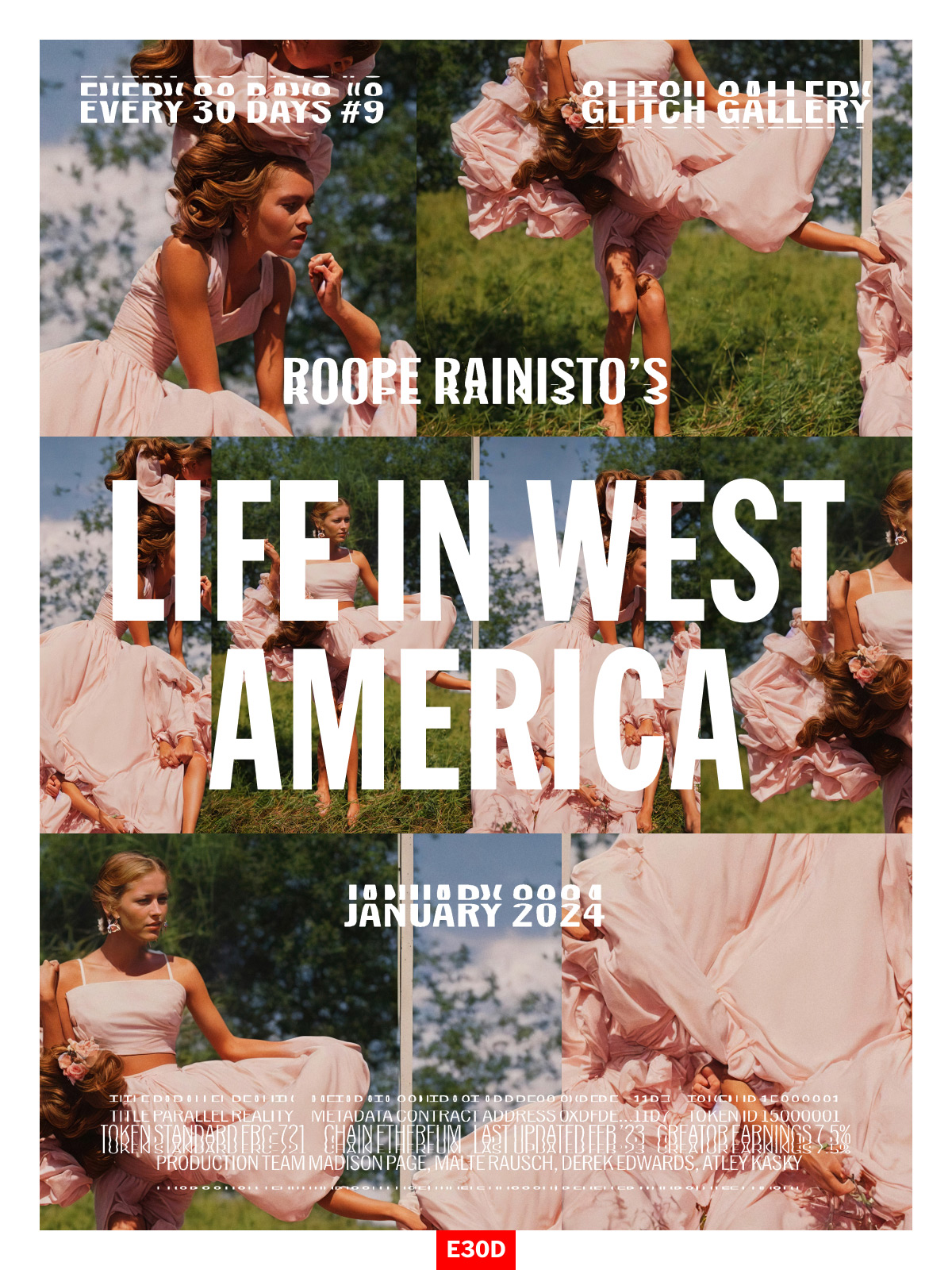Often times in artistic spaces, acknowledgement of a work’s cultural importance unfolds over time.
In other moments, there is early recognition.
Roope Rainisto debuted “Life In West America” in February 2023, and with it, a seemingly new milestone in the advent of machine-assisted creative work was reached. Almost instantaneously, the AI-generated collection sliced through the stream of artificial media flooding our collective digital spaces.
Rainisto’s innovations didn’t just include the novel use of a (then) new high resolution diffusion model to create the collection’s images – a tool that had just started to gain widespread recognition amid the year’s mainstream interest in AI.
Rather, the collection’s strength emanated from the seemingly differentiated language distilled from these models – a cohesive collection of work that possessed a peculiar mix of comforting familiarity and unsettling historical fiction.
.jpg)
“Life In West America”, or LIWA, is a collection of 500 AI-generated images.
At first glance, the outputs reflect the tradition of documentary photo books, presenting stereotypical Americana scenes rooted in the 1960s milieu of Cadillacs, blue jeans, and diners.
LIWA subtly echoes the works of Diane Arbus and Robert Frank’s “The Americans” (1958) – works that capture American society in the medium of photography.
In the introduction to the latter work, the writer Jack Kerouac praised the “humor, the sadness, the EVERYTHING-ness and American-ness of these pictures,”1 a description that could be equally applied to the lives being lived in Roope’s “West America.”

However, Rainisto’s work does more than revisit a distinctly American aesthetic with a sense of nostalgia. It reimagines it as a symbolic register for storytelling, using synthetic images to evoke emotional responses. To a global audience, “Life In West America” offers a sense of déjà vu, of recognition or, perhaps, a vague recollection, of the cultural versioning of America depicted over history.
While LIWA’s specific imagery may be fictional, the cultural fragments they’re composed of are not; simply, hints of each output are woven from the pop culture fabric that trained the generative model.
And yet, how could Rainisto, a Finnish artist, perfect this essentially American aesthetic?
This traditional American aesthetic, largely the product of advertisements and media idealizations, has been consumed worldwide for generations. For the same reason, this collection resonates and evokes emotional responses from audiences outside the US.
The expansive scope of the collection, encompassing various settings from intimate spaces to workplaces, underscores its lineage within the documentary photography tradition. LIWA zeroes in on social life, a perspective also evident in the traits of the collection, grouped by the artist in different ways the collection’s fictional subjects relate to one another in space (union, trinity, cluster, void).
%20(2023).jpg)
The refraction through AI is most evident in the glitches typical for diffusion models of the last few years – disfigured hands, misplaced body parts, fractured perspectives. These flaws disrupt the purely photographic nature of the project, infusing the foreign element with a surreal and occasionally grotesque character.
Rainisto’s deliberate selection of these anomalies showcases their potential for artistic impact, enabling the artist to simultaneously reference and estrange the documentary aesthetic.
.jpg)
Life After Photography?
Remarkably, while Rainisto’s work nods to the documentary aesthetic of a past era, it concurrently serves as a contemporary chronicle, documenting the aesthetic evolution of advanced diffusion models.
Such models start from a pattern of random noise and gradually refine it into a coherent picture, effectively “imagining” a text input. While earlier, groundbreaking AI works like Claire Silver’s “Genesis” poetically rendered the emergence of form from noise,2 LIWA captures the last remnants of formlessness in generative images, documenting an era of transitions before image production is dominated by flawless models – a reality fast approaching.
%20(2023).jpg)
The transformative potential of generative AI in image-making is already evident. This gallery believes that the significance of Rainisto’s work will persist far into the future, as the impact of this technology broadens. Put simply, collections like “Life In West America” are poised to be recognized as among the earliest and most artistically significant explorations of this nascent technology.
Notably, the term that emerged in early 2023 to describe this work is “post-photography”.
Photography has always stood in relation to the material world, which it captured first on light-sensitive plates and eventually through digital detectors. Post-photography was intended in the sense of a technological era “after” photography, understood as a referential medium.
Post-photography does not picture the world. Rather, it imagines it based on a synthesis of existing images of the world. Such a form of image-making, the category of implies, severs the “direct” relationship to the world while retaining a connection to the visual language of photography.
There’s an inherent irony in considering that the term “post-photography,” conceived a decade prior to describe the work of artist-photographers navigating a digital world saturated with images,3 is now applied to artistic work that has been described as an extinction event for art photography.
%20III.%20Roope%20Rainisto_%20Life%20In%20West%20America%20(Red%20White%20And%20Blue)%20(2023).png)
While it appears too early to find definitive categories for an evolving body of work, the notion of “post-photography” seems adequate insofar as it highlights the references to the photographic medium with regard to composition, lighting, and perspective.
As Alejandro Cartagena rightly points out: “[T]he computer models understand framing photographically […] These models are looking at images, and the most predominant type of image out there is the photograph.”4
For this reason, the critical appreciation of these images can continue to view them as part of the tradition of photography.
Parallel Reality

This month’s Every 30 Days exhibition features “Parallel Reality” from the “Life In West America” collection, showcasing a divided image reminiscent of a diptych’s form.
The twin rectangles border each side of the image, providing a sense of balance and framework.
According to the artist, it is LIWA’s only intended diptych in the series.
Each segment features a young woman, clad in pink, ensnared in a tumult of fabric, with additional hands and legs in disarray. The entire image is constructed in such a way that the viewer’s vision naturally gravitates towards the faces, which stare out of the image.
It is upon a second glance that the viewer becomes aware of the extent to which the image is populated with distorted shapes. Further contemplation reveals that the left and right sides are depicted from distinct perspectives. In this manner, the composition leads the observer from an initial perception of order to an appreciation of the underlying layers of disorder and noise.
Through its defects, the image deliberately reveals itself as artificially “made”.
The women’s poses, reminiscent of conventional photo shoots, are rendered with the polished aesthetic typical of high-gloss imagery. Such an eroticized portrayal, aligning with the standardized ideals of “feminine beauty”, is a predictable outcome for works derived from training on existing pop culture visuals and should not be mistaken for an endorsement of it.
By relying on the conventions that are characteristic of photography, the image appears familiar at first – we have all seen countless images with similar poses.
Yet, such a display of “feminine beauty” is rendered absurd due to the exaggerated traits, and displaced fragmented body parts – hinting at the absurdity latent in this “American ideal”.
Unlike the violent depictions of body parts found in the works of Surrealist artists such as Hans Bellmer, however, this arrangement incorporates the visual turmoil into the scene, portraying it as an unexpectedly seamless shift from structure to disarray.
This “layered” composition thereby attains its unique sense of surrealness – the revelation of the profoundly unusual within the ordinary. The familiar aspect is our acknowledgment of the photographic and societal norms the models are trained on, while the remnants of raw chaos strike us as odd and non-human.
LIWA is a study of American types, tropes and myths. The collection presents a grotesque idealization of the female body as one such myth, yet it refrains from imposing a specific evaluation of this myth upon the viewer. Commentary occurs here by questioning the viewer’s perception. How familiar does this “parallel reality” appear? How ideal? How grotesque? And what does this say about our visual culture?
The Value of Artificial Images
Generative AI is touted as a means to democratize creativity by unbundling the relationship between mastery of techniques and the artist who creates them. However, the more one encounters AI-generated art, the more distinct LIWA seems.
This distinction arises because the “amateur” use of AI tools often exhibits similar limitations seen in amateur work across other mediums: recurring themes, unbalanced compositions, and overly derivative styles, among others.
By contrast, Rainisto, a practiced photographer for decades, accomplishes with LIWA a true tour de force in photographic composition – as well as a masterful use of the characteristic AI glitches. The collection suggests that the proliferation of AI-generated images, rather than homogenizing creative expression, will emphasize the scarcity of high-quality work and the limited expanse of human attention.
As the influence of AI in society and culture grows exponentially over the coming decades, this gallery believes that value will concentrate and amplify where exceptional artistic quality is coupled with the scarcity of digital objects.
“Life In West America” is among such work.
.jpg)
Generative AI might be viewed as a vast amalgamator, collapsing various media, styles, and references into a generalized eclecticism.
However, the distinct characteristics that have evolved within specific disciplines like photography remain vital for an artistic practice such as Rainisto’s. Despite the all-encompassing nature of generative AI, the nuanced elements and traditions of individual mediums continue to play a critical role in shaping and defining the art that emerges from this new technology.
Each of LIWA’s 500 pieces are distinct, yet they collectively exhibit an exceptional thematic harmony.
This coherence not only fosters the same kind of network effects that have solidified “long-form” generative art collections as a standalone media genre, but also allows the collection to construct a world that feels narratively structured.
Despite the fact that Rainisto’s work eliminates all attributes that have traditionally been associated with photography, it thereby opens a new function for “photographic” storytelling and documentation.
Ultimately, Rainisto’s LIWA offers a depiction of American society – not as it was, but as it chose to represent itself. The collection is a documentary and fiction delving into the dreams, archetypes, and fears ingrained in America’s visual self-portrayals, refracted through the lens of AI.
In this way, LIWA serves as a broken mirror; it doesn’t reflect our actual image but rather a prism of all the images we have consumed, documenting past archetypes and the visual language of a future already underway.
-
Jack Kerouac, “The Americans: Introduction,” available at https://oscarenfotos.com/wp-content/uploads/2012/05/p1_americans_intro.pdf ↩
-
https://www.glitchmarfa.com/e30dgallery/genesis/ ↩
-
Robert Shore, Post-Photography: The Artist with a Camera (London: Laurence King Publishing, 2014). ↩
-
Cited in Giden Jacobs, “A.I. Is the Future of Photography. Does That Mean Photography Is Dead?,” available at https://www.nytimes.com/2023/12/26/opinion/ai-future-photography.html ↩

